We're an affiliate
We hope you love the products we recommend! Just so you know, we may collect a share of sales or other compensation from the links on this page at no additional cost to you. Thank you if you use our links, we really appreciate it!
Even though dogs and cats are both wonderful household pets, they have a long history of being natural enemies.
Does your dog scare, chase, or even attack cats? If so, then don’t worry. Dog aggression towards cats is a common problem in many pet homes. But the good news is that it can be fixed.
Some people believe that their dogs are just “being playful” when they see them chasing or attacking cats. However, this is not usually the case.
Dogs that exhibit aggression towards cats are often doing so because of an underlying problem. It is important to be aware of this before proceeding to correct the behavior.
Dogs may become aggressive towards cats for a variety of reasons, such as fear, dominance, territoriality, etc. The key to fixing this behavioral problem is to identify the root cause and address it accordingly.
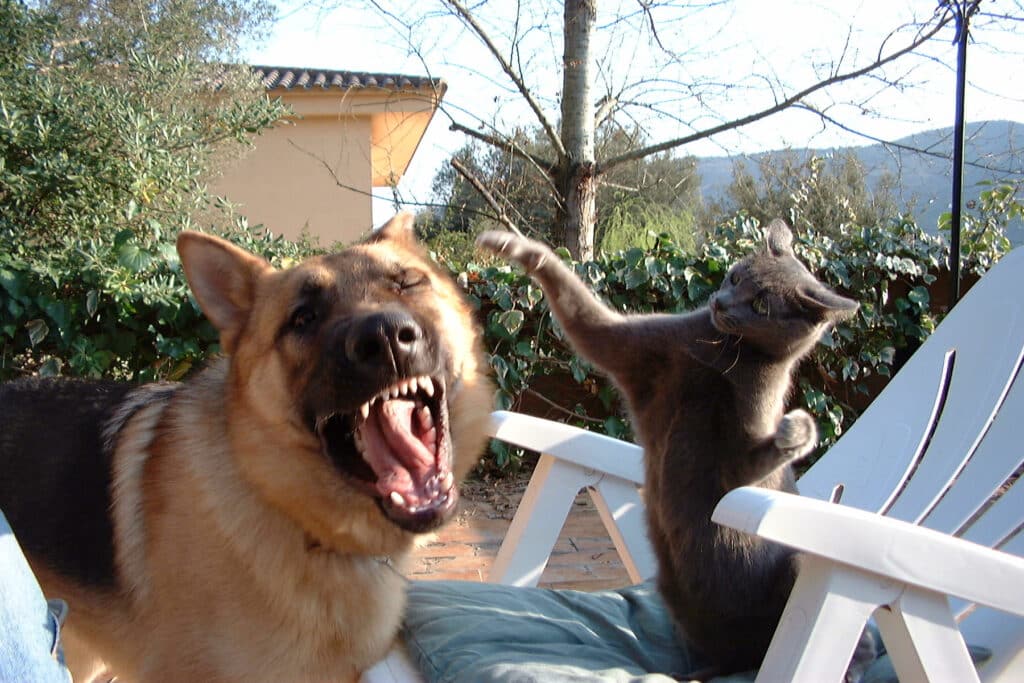
In this post, we will provide you with some practical tips on how to stop dog aggression toward cats. We’ll also cover some of the most common causes of this behavior and how to address them.
What is Dog Aggression?
Do you have a dog that barks, snaps, or growls at your feline? Or maybe your dog chases your cat around the house?
This is known as dog aggression, and it can be a real problem. It can also be a very unsafe situation for both your pets when things get worse.
In most cases, dog aggression is caused by fear. Your dog may be afraid of cats, or they may think that cats are a threat. This can be a difficult behavior to change, but it’s not impossible.
If you’re having trouble with fixing dog aggression, the next thing you need to do is get help from a professional.
How To Tell If a Dog Is Aggressive Towards Cats?
Dogs that are aggressive towards cats may exhibit different behaviors. These are a few that you can look out for:
– Does your dog snap, bark, or growl when they see a cat?
– Does your dog try to chase or corner cats?
– Does your dog attack or try to hurt cats?
If your response is ‘yes’ to any of these questions, then your dog may have a problem with cats. And if left unchecked, this problem could worsen over time.

It is important to be aware of these behaviors and to take steps to correct them before they lead to a scuffle.
Why is My Dog Aggressive Towards Cats?
If your dog is acting violently toward cats, it’s important to work out what the problem is. It could be that your dog is simply naturally predatory, or it could be that they are acting out of fear or anxiety. Once you are familiar with the problem, you can then begin to look for solutions.
The following are a few reasons why your dog might be acting aggressively toward cats:
First of all, dogs can be territorial. They may see cats as intruders in their space, or they may view them as competitors for resources, like food or toys.
This can escalate quickly into a fight, especially if the dog perceives the cat as a threat to the family.
Dogs may also be aggressive towards cats because of their instincts to hunt down prey. When they see a cat, they may think that they’re prey and feel the need to attack.
Another reason why dogs may be aggressive toward cats is if they’ve had negative experiences with them in the past.
If your dog has been attacked or bullied by a cat, they may start to see all cats as a threat. In such circumstances, it’s important to give positive reinforcement when your dog is around cats. Give them treats and praise them when he behaves calmly around them.
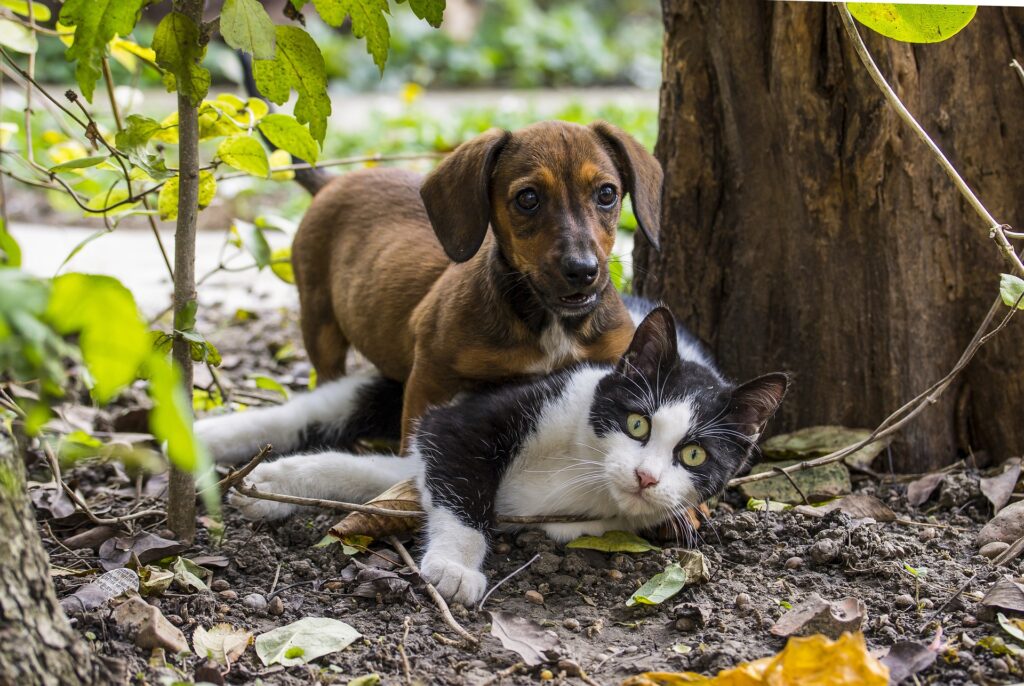
A further explanation for this rivalry is that cats and dogs simply don’t speak a similar language.
Dogs communicate through barking and body language, while cats use a variety of feline voices and body language cues that can be difficult for dogs to interpret.
This lack of understanding can cause aggravation and even fear on both sides, leading to aggression.
Some dogs may simply have a bad disposition towards cats. This could be due to a lack of socialization with cats when they were puppies, or it could be due to an inherent dislike of felines.
The worst dog breeds for cats are highly predisposed to show aggression towards felines than other breeds.
Luckily enough, you can take some actions to reduce the chances of your dog becoming aggressive toward cats.
Will My Dog Hurt My cat?
Dogs and cats can be great friends and playmates. But, when the two pets are in the same room, they may be very curious about one another. The dog may start chasing the cat if they feel intimidated or when they get apprehensive.
If this happens, they could inadvertently hurt the cat by cornering or trying to bite them. In addition, when the pets play too roughly, your cat could get hurt in the process.
It is best to ensure that your pets are playing in a controlled environment with a clear escape route for the cat.
How Do I Stop My Dog from Chasing My Cat?
Chasing is an intense emotional behavior that can be frustrating for both dogs and cats. It’s also a behavior that can be difficult to change.
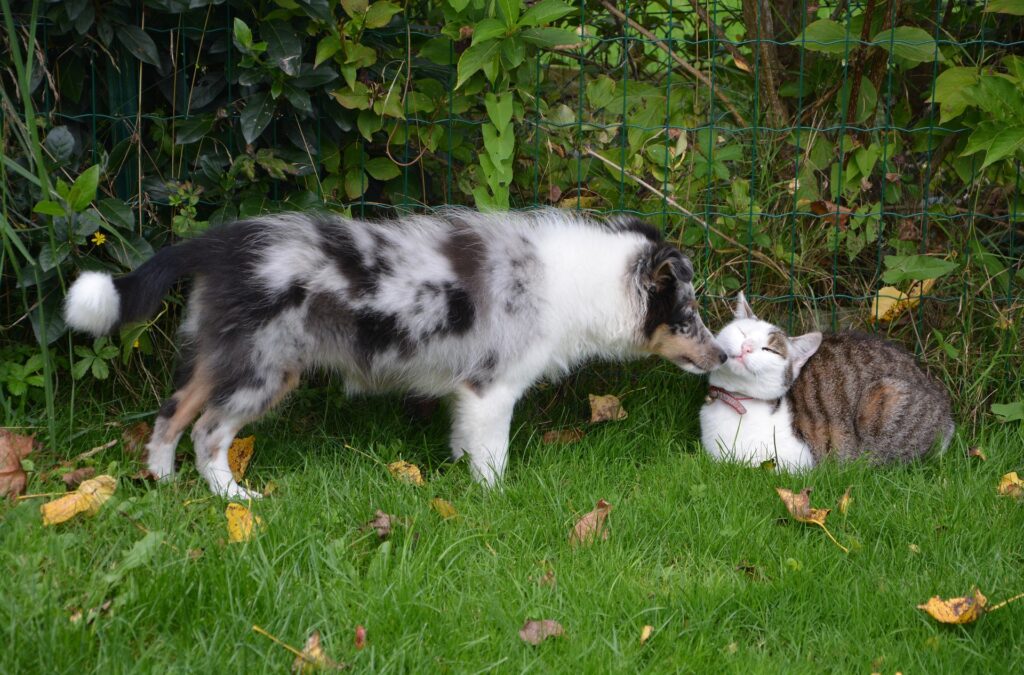
The first thing you need to do is figure out why the dog is chasing your cat. Is it because the dog wants to play? Or are they looking for attention? If it’s the latter, then there are different ways you can approach this problem.
Here are some tips:
1. Keep your cat inside the house or in a safe pen while outdoors. This will keep them away from potential playmates, especially when not supervised.
2. Use water to discourage your dog from chasing the cat. It’s best to not use cold water in this step. But instead, get lukewarm water that is a bit on the cooler side. You can then try spraying your dog with water using a squirt bottle if he starts chasing your cat.
3. Another option would be to put a barrier between the two of them. This could be another room in your house, a dog gate, or a door that’s closed all of the time. Whatever you choose, make sure that the barrier does not allow direct access between them.
How To Stop Dog Aggression Towards Cats
Knowing how to stop your dog’s aggression towards cats is a step towards having a peaceful multi-pet home.
1. Introduce your cat and dog properly
You can stop your dog from being aggressive towards felines by introducing them properly since puppyhood. Pets who are well-introduced from their early years are less likely to be violent as they grow.
Make sure to introduce them positively so they learn to cope with new experiences calmly. This should take place in a controlled environment and it should never be hurried.
Ensure that both pets have their own rooms and start the introduction process by swapping their scents. You can then gradually monitor how they behave before their first meeting.

This process should always be supervised to prevent any scuffle from breaking out.
I strongly recommend that you read our comprehensive guide on how to introduce a cat to a dog at home.
2. Provide enough exercise to your dog
One of the best ways to stop dog aggression toward cats is to provide your dog with plenty of exercise. A tired dog is a good dog! Dogs that have a lot of energy are more likely to be aggressive.
Make sure you are taking your dog on daily walks and runs, and playing fetch or other games with them regularly. If your dog does not have a way to vent his pent-up energy, they may take it out on your cat.
If your dog is displaying aggression toward cats due to prey drive, then this is a good place to start.
3. Avoid games that encourage aggression
While playing tug-of-war or other roughhousing games with your dog, be careful not to let them get too worked up. If they start growling or snapping at the air, it’s time to get a break for the day.
According to Dr. Jason Nicholas from Preventive Vet, Tug of war games do not necessarily cause aggression in dogs when done in the right manner.
4. Don’t allow your dog to chase or harass cats
Do not allow your dog to physically engage with the cat intensively. This can lead to the cat becoming fearful and guarded when around your dog, which in turn can cause your dog to chase the cat even more.
If you see your dog preparing to chase the cat, interrupt the behavior and give them something else to do.
Your doggo may need a few trials before they realize that the kitty is off-limits. But with time and consistency, you should see their behavior changing for the better.
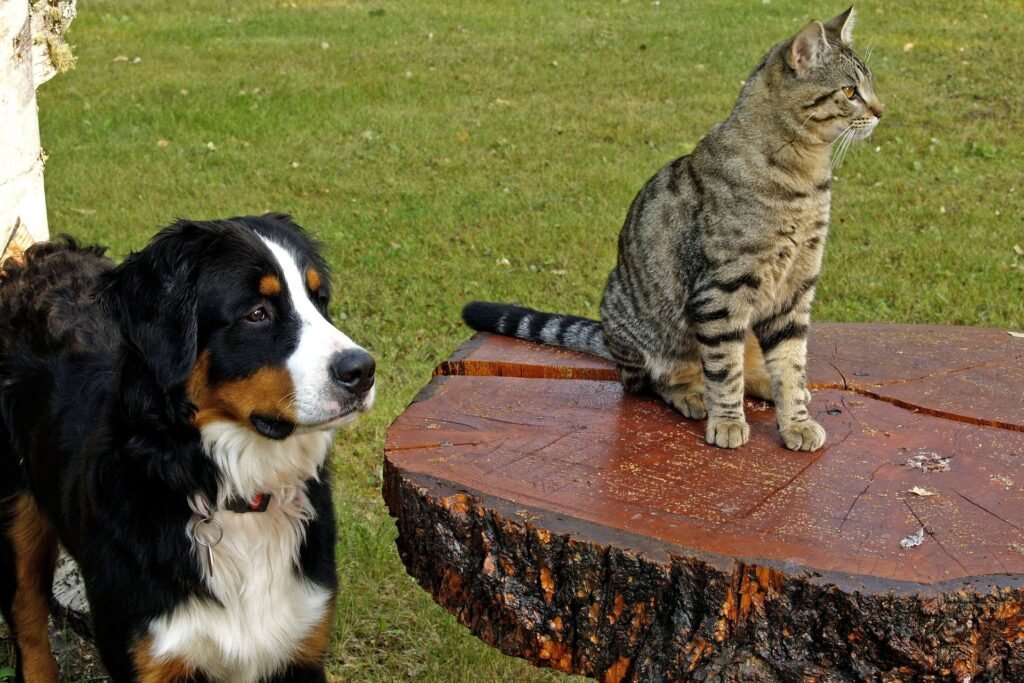
It is also very critical that your dog creates positive associations with the cat. Feeding the cat near your dog, providing ample attention, and letting the dog sniff the cat but not engage. And keeping the dog on a leash near the cat will all help to cultivate positive associations.
If you have an especially skittish cat, you can also keep your dog leashed near the cat to prevent any accidental scare.
Make sure to pet your cat in the best way whenever they feel harassed by your dog. This will reassure them of your love despite aggression from the seemingly unfriendly housemate.
5. Teach your dog basic commands
You’ll also want to work on basic obedience commands with your dog. This will help them obey you when you give instructions, instead of reacting impulsively.
Teaching your dog some basic commands will also help them tone down their high prey instincts. You can begin by training them to sit and stay.
This will help you to control them better in circumstances where they might be attracted to act aggressively.
You can now instruct your furry friend to calm down whenever they are with cats. Make sure to supervise every meeting between your dog and cat until when they are getting along.
6. Never punish your dog when they’re around cats
This will only make the situation worse because the dog will associate being around cats with punishment.
Instead, focus on rewarding your dog when they are behaving well around cats. For example, if your dog is sitting calmly next to your kitty, give them a dog treat.
This will inform them that they have done something incredible.
7. Provide your cat with a safe place to retreat
Finally, make sure that you’re providing your cat with a safe place to relax away from your pup. This could be a room where the dog’s entrance is restricted, or it could be something as simple as a cat tree or scratch post.
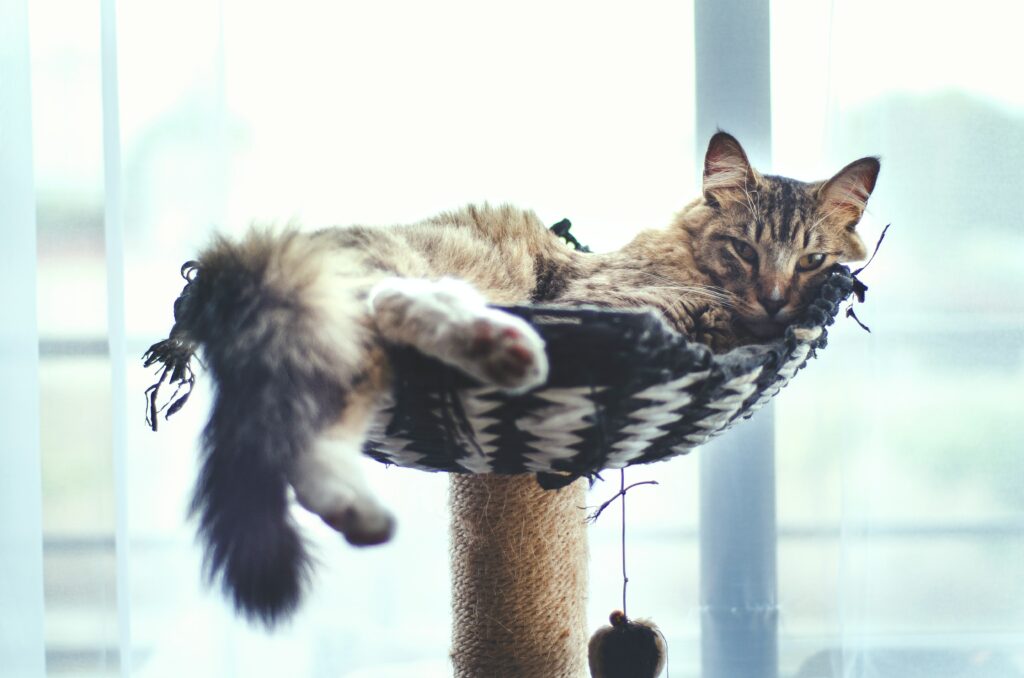
You can equip your kitty’s room with a natural cat pheromone diffuser. This will help them to calm down whenever they feel stressed or intimidated by your dog.
8. Help your dog get over their fear of cats
If your dog is acting aggressively because of fear or anxiety, the solution will be different. In this case, you’ll need to work on helping your dog feel more comfortable around cats.
This may involve slowly introducing them to each other under controlled circumstances, and providing plenty of treats and praise when they behave well around each other.
You may also need to consult with an animal behaviorist or canine trainer to help you work if your dog is too fearful of a cat.
9. Be consistent with training and disciplining your dog
Dogs respond best to well-defined rules and consistent fair consequences for not following them.
Be sure to let them know what they can and can’t do, what they can and can’t eat, when they can and can’t go outside with the cats, etc.
When your doggo does something that they are not expected to do, don’t yell at them. Instead, stay calm and put them in a “time out” by placing them in a dog crate or another room for about 10 minutes.
Also, remember to praise and pet your dog when they do something good too!
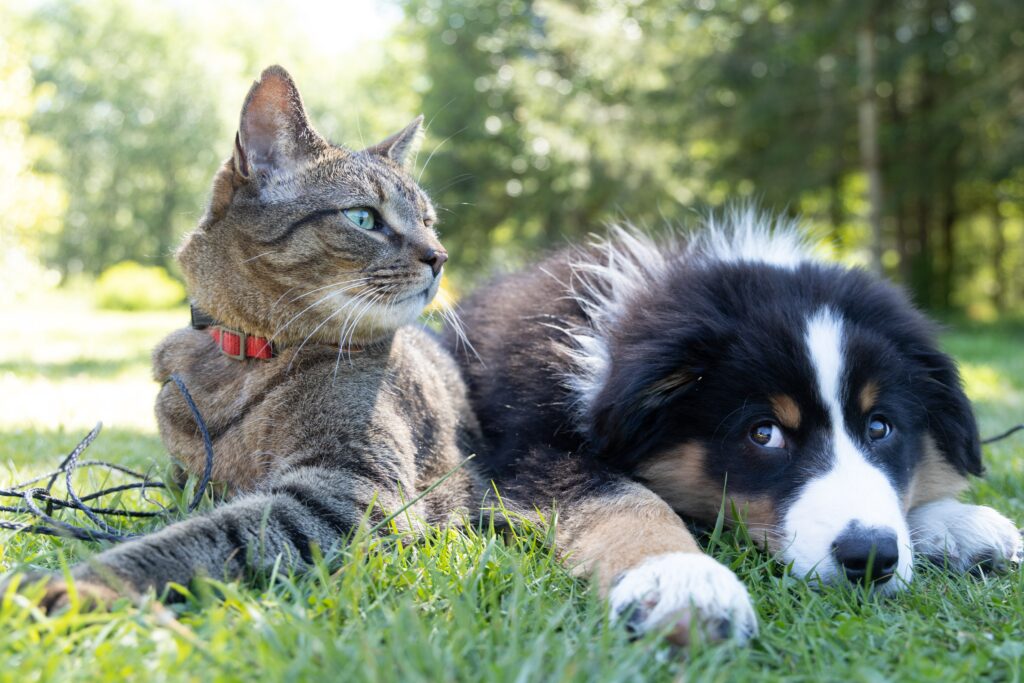
If you go by the above guidelines, you should see a drop in your dog’s hostility toward their feline housemates.
Many of these tips are based on positive reinforcement, so they are easy to follow and will not require a lot of time or effort.
Keep in mind that it is good to be patient during the training. Make sure everyone in your family follows the same rules, for better results. Good luck!
How To Tell If Your Dog Is No Longer Aggressive Towards Cats?
If you’re not sure whether your dog has stopped being aggressive towards cats, here are 3 things you can do to test the situation.
1. Re-introduce your pets
First, try re-introducing your dog to a cat in a controlled environment, like your backyard or a park. If your dog is calm and playful around the cat, that’s a good sign that he’s not feeling threatened anymore.
2. Observe their body language
One way to tell if your dog is no longer aggressive towards cats is by their body language. A dog that is feeling aggressive will usually have their hackles raised, and their ears back, and they may be snarling or growling.
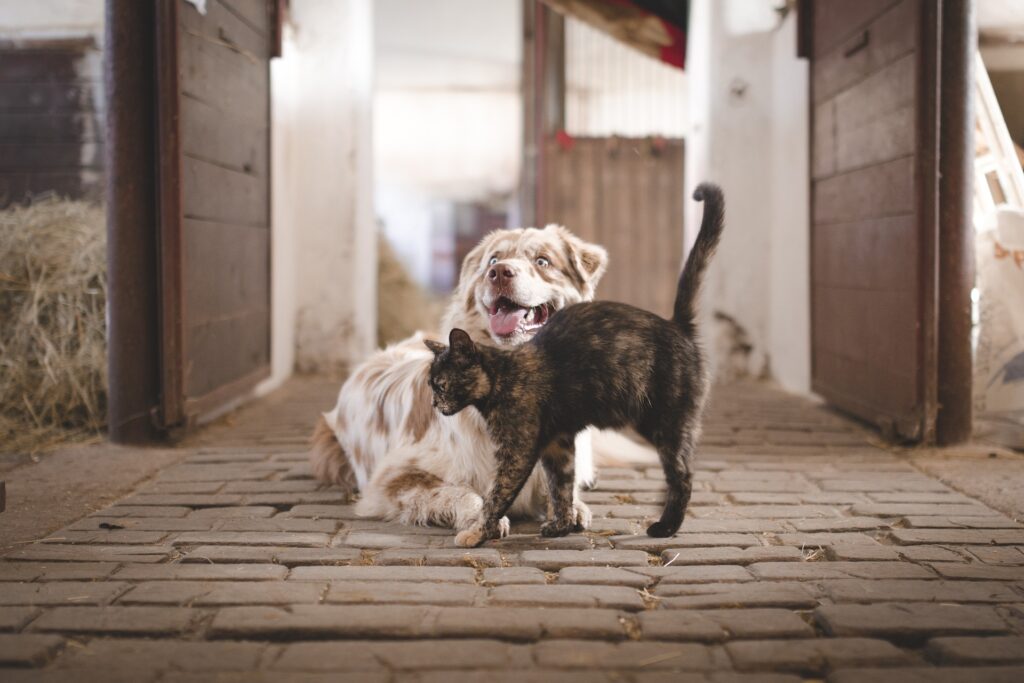
A dog that is relaxed and not feeling aggressive will have their hackles down, their ears forward, and they will likely be wagging their tail.
If you see your dog exhibiting these signs of relaxation around a cat, it means that they are no longer feeling aggressive and are beginning to accept the cat as part of the family.
3. How they interact with cats
A sure way to tell if your dog is no longer being aggressive toward cats is by the way they interact with them.
If your dog used to chase or bark at cats but now is ignoring them or even playing with them, it means that they are no longer feeling aggressive towards them.
A cat who feels secure at home can freely share a bed with your pup. This shows that they have become good buddies and are willing to stay together.

One more approach to testing the situation is by walking your dog past the room where your cat is. If they don’t react negatively or try to attack the cat, that’s another good sign.
If you see your dog exhibiting these changes in behavior, it is a good sign that the aggression training is working and that your dog is slowly but surely becoming less aggressive toward cats.
If you’re still not sure, it’s best to consult with a professional who can help you determine if your dog is safe around cats.
In Conclusion
There are a lot of things you can do to stop dog aggression toward cats. But the most practical thing is to be consistent in the process.
Dogs thrive on rules and boundaries, so make sure you set some up for your pet. With time and patience, you can stop dog aggression towards cats and help your pet live peacefully with your feline friends.
If you are particularly concerned about dog aggression towards cats, then you should consider looking at the best dog breeds for cats. These breeds can easily get along with cats because of their calm demeanor.
Laura is the founder of Furs'n'Paws. She is a also a pet writer and expert with more than 20 years of experience of working with dogs and cats. She developed a very strong love for animals at a young age. Her passion led her to establish a thriving pet sitting and dog walking business in Dubai. As an expert in pet training, behavior, and nutrition, Laura is committed to helping pet owners and pet lovers by offering high-quality information on a wide range of topics.


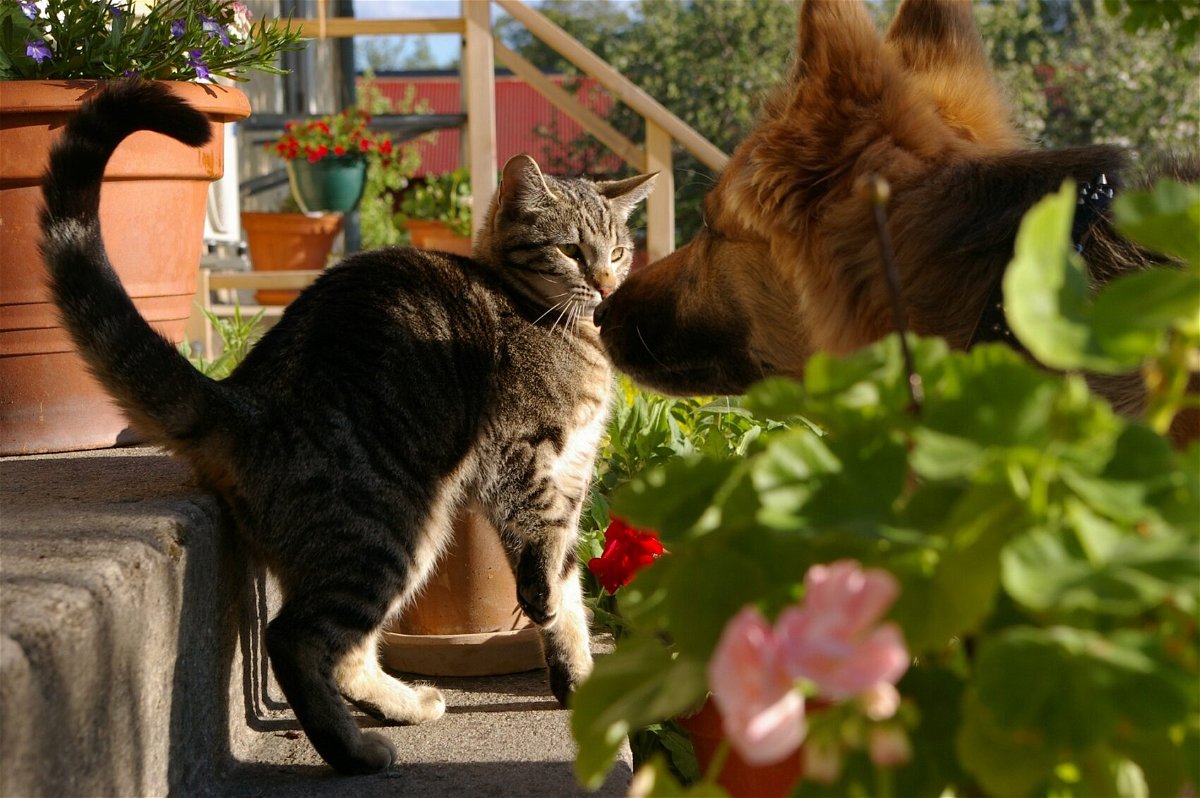
No responses yet